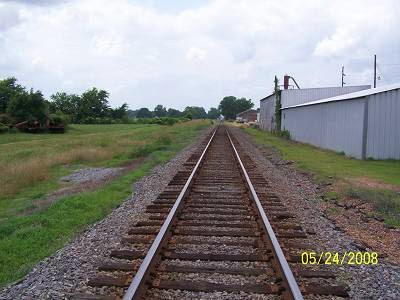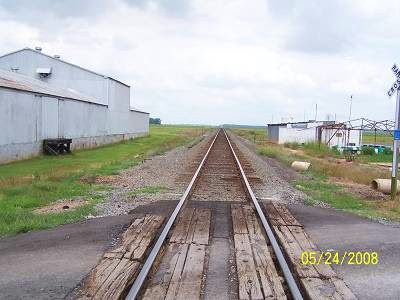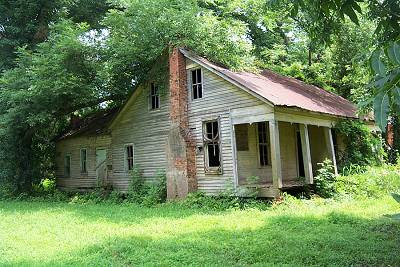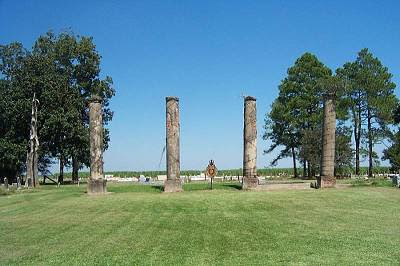You can travel 2 ways from Bunkie to Cheneyville. One is US 71 and another is by Shirley Plantation Road (La.1177) that rides along Bayou Boeuf. This area is as up front"Central Louisiana" as it gets. From large country churches and small field workers' homes to large plantations with "big houses" resplendent with all the Greek antebellum trappings, to small cottages, this is Cotton Louisiana though the crop is changed when financial considerations prevail. The ghosts of the Old South ride the breezes blowing across the fields, under the oaks and between the giant cedars.
It's a place where you can imagine hearing Pearl Bailey (no relation) singing "Summer Time". It's a place where the fictional portrayals of "Long Hot Summer" and "Steel Magnolias" wouldn't be fictional at all, but scenes from everyday life.
I once chased bayous and rivers. These are a few personal words about this area from a long ago memoir.
Revisiting visions of the past becomes more important as those visions become more distant.
In my youth, my family had to travel the length of the state to see our relatives. I learned the roads: US 61 from New Orleans to Baton Rouge, US 190, from Baton Rouge to its intersection with US71, west of Krotz Springs, US 71, from 190 to Alexandria, and La.1, or US 71, sometimes, from Alex (La. shorthand) to Shreveport. Extreme boredom would cause my father to alternate. Between comic books and throwing up, I watched the sides of the roads, always wishing I could get off this scar in my brain and explore down the little roads. I knew adventure and treasure were out there. What I didn't know was how close to that worn route those treasures would be.
The trips would only get interesting, to me, when we finally got into the hills of north La. We had always lived on flat land. The hills were different and like that part of Shreveport where my grandmothers both lived. You could skate, at speed, on Wilkinson Street.
Now, I am roaming those once hated flat lands that Bayou Boeuf and Cocodrie tie together. US 71, south of Alexandria, once considered an endless stretch of the trip, La.29, south of Bunkie, and La.182, south of Whiteville to Washington where the Cocodrie and Boeuf join to form Bayou Courtableu. This area defines a distinct region. It is a region of transition. Homes define the culture and the styles change gradually along these routes. It begins with very Central Louisiana, traditional midwestern farm houses, changing to the Cajun homes further south, marked by their exterior staircases to the attic. Large Greek Revival plantations are scattered throughout. In reality, there is no defining border between cultures and architecture, only a weighting from one group to another. Louisiana is the ultimate poorly stirred mixing bowl.
So here I go again up 71. If you are reading this little tale in expectation of twisting, thrilling travel. Sorry. If you want to see what I consider treasures, yes, a lot of rotting houses, slimy bayous, and graves, you're at the right place. I feel like I have to do it all before I can start on the hills. Those past visions do get much more interesting when revisited. And, those distant treasures seen as a blur from an un-air-conditioned '49 Dodge weren't so distant after all. In many cases they lay just a few feet away from what I consider Louisiana's other "Mother Road", US 71.
That was from "a while back".
As usual, I don't know how to present this. Let me get this "Mushroom Hunt" out of the way and then I'll pile on with Cheneyville.
The Hunt Continues
From the hotel I brought the fellas up 1177 which is the west route up the Boeuf. I told one of them, when asked what bayou that was, "If you see a bayou, call it the Boeuf because it twists around all over this alluvial plain and you'll probably be right".

The bayou.
.jpg)
Not a Greek, but maybe antebellum.
.jpg)
This is the country church I had in mind. It was letting
out when we passed by. I can't describe the scene.
.jpg)
One of the freedoms which I hold dearest is my freedom to
change my mind. I think that, to avoid redundancies, I'll move
forward with hometown lady, Mary Marks Soloman's pamphlet
on Cheneville and fill in between her paragraphs with pictures
and my comments.




.jpg)


_(400_x_400).jpg)
.jpg)
.jpg)


{Photos needed}

_(400_x_400).jpg)




Below the railroad is mentioned. I spent some time
in Cheneyville trying to figure out how the Southern
Pacific met the Texas & Pacific. It was a hot long
afternoon similar to this one.
_(400_x_400).jpg)
I was heartened by torn up ties. I could lead you to believe
these were from the SP, not so. Still, they were a mood
setter.
_(400_x_400).jpg)
Before the hunt on the south side of the tracks began, I
looked up and down the north side. I couldn't see the connection
from that side. The high weeds, below on the right, marked
the spot.
.jpg)
The truth lay beyond the rails.
.jpg)
Looking north.
.jpg)
Looking south.
.jpg)
.jpg)
.jpg)
Then I went into the farmer's field. The GPS said I was there.
The farmer knew they were there, also.
.jpg)
.jpg)
.jpg)
The next stops would be Haas and Eola to the south.

I'll pop in a few pictures of Front Street, US 71.
Some are older, some are more recent. Some depict
how Cheneyville has deteriorated quickly in the last
of the 20th and the beginning of the 21'st Centuries.
Her most recent loss has been the parish jail, once a school.
There is not much left alive in Cheneyville.
Below was found where she describes "Old Town" as being.

This may or not be of what she is speaking.
.jpg)
Not all the homes were in bad shape.
.jpg)
This is the present Methodist Church. That is my guess
based on its design.
.jpg)
.jpg)
Here's the old dominoes pavilion on Front Street near
the railroad tracks. Once it was a place where old men
played the day away.
.jpg)
Now it's not.
_(400_x_400).jpg)
This shot was taken from there.
_(400_x_400).jpg)
A lovely place.
.jpg)
Old businesses.
.jpg)
This is one of the once busy antique shops.
.jpg)
This was once a home near the tracks.
.jpg)




This picture was taken on the mushroom ride. It is not
my best. Below it will be better.
.jpg)
.jpg)
_(400_x_400).jpg)
.jpg)
I had mistaken this tour sign for the Northup Tour.
The Bennett places were on the Northup Tour, named
for a man who had been kidnapped into slavery in these
regions. Much more on that later.
.jpg)
.jpg)
.jpg)
.jpg)

.jpg)
Of course that's the Boeuf.
.jpg) '
'Notice the use of the word, "Planter". He was not a farmer.
Farmers are workers. The "Planter" may have dallied in
the soil from time to time, but it was not his job. He had
overseers for that.
.jpg)
This house sat nearby. I suspect it had something to do
with the cemetery.
.jpg)
The author is black, thus the familiarity with the historical
places of interest to that community.

What was the "Alliance"?
{Photos needed}
.

I was in the Bennett Store a while back. It was the last
opportunity to visit it while it was there. I wonder if the
ghosts made the trip?
_(400_x_400).jpg)
Now the store and house are saved, elsewhere.
_(400_x_400).jpg)
This is the way it looked in the state I found it on US 71.
.jpg)
I was afraid to go upstairs. Shame on me.
.jpg)
Looking out the side. That is a kitchen in green.
.jpg)
Across the highway was the family home.


The Cheneyville Horror?
_(400_x_400).jpg)
In response to my long ago write, a reader, Ms. June wrote,
" Your site and photos brought back so many good
memories of my childhood in Cheneyville, Louisiana.
I wanted to give you the story about the house and
store on page 2 of your Alex to Washington trip.
That's the old Bennett house and store. My friend
Veronica grew up in that house. She once told me
that the house had at one point been a funeral
parlor. She may have just said that to scare me
though!" [The store and house are two different
places.
"The store was vacant and we played in there often.
Someone found a box of receipts including one from
1817 (when the store was new) that showed James
Bowie shopped there; he invented his knife nearby
and once owned a lot in Cheneyville".
"We never went up those stairs either! Ezra Bennett
came from New York and bought the house and store
in the 1830s. He is buried in the graveyard over
by Trinity Episcopal Church. I'm so sad to see the
house and store are in ruins now. I wish someone
would restore them".
"Thanks for the photos and the trip back in time. :) "
Ms. June, you got your wish.
Here's a bit about Bowie's presence in the area.
"In his teens James Bowie worked in Avoyelles and Rapides parishes, where he floated lumber to market. He invested in property on the Bayou Boeuf and traded in 1817–18 at what is now Bennett's Store, south of Cheneyville. He was fond of hunting and fishing, and family tradition says that he caught and rode wild horses, rode alligators, and trapped bears. When grown, Bowie was described by his brother John as "a stout, rather raw-boned man, of six feet height, weighed 180 pounds." He had light-colored hair, keen gray eyes "rather deep set in his head," a fair complexion, and high cheek-bones. Bowie had an "open, frank disposition," but when aroused by an insult, his anger was terrible. During the War of 1812, James and Rezin joined the Second Division, Consolidated, a unit that contained the Seventeenth through Nineteenth regiments, drawn from Avoyelles, Rapides, Natchitoches, Catahoula, and Ouachita parishes. In January 1815, according to family records, the brothers were on their way to join Andrew Jackson's forces at New Orleans when the war ended".
From Here
Returning to Mary Soloman's pamphlet:


Cheneyville was joined in the anti lottery movement.
This is a little boring but what seems important to
me is the list of prominent people in the community.



That does sound a little familiar. These guys were T Party
People. They saw what crooked government was doing
and found it "repugnant to ur state pride, an insult to
our manhood, abhorrent to public morality, contrary to
our State Constitution, consequently undemocratic and
contrary to all Democratic principles".
I am sure that if you crossed any of these gents, a duel
on the sandbar would be your next invitation.

They saw themselves as leaders.

Of interest here is the mention of the Town Talk, still
Alexandria's newspaper.
The members:

Below is a list of pictures I did not get from my source.



This is the closing picture from the ride. After the Anti-
Lottery call to arms, it's a bit weak. What you have here
is two old guys who can't figure out where to park their
bikes. Possibly it was the heat to offer them an excuse
I took 20 more pictures as they moved around the field.
I'll spare you those.
More below now that the ride is safely over.
Safe for you and I.
.jpg)
Remember I mentioned the Northup Tour back at Trinity
Episcopal. He landed in this area and kept a diary of
his time spent as a slave. It is a picture through another
lens of how things were.
Below are excerpts from Northup's odyssey. Be aware, it
is written by a man whose freedom was stolen. I have
not read the whole book. I copied it and can send it to
you. It is out of copyright.
I am assuming the tour is named after him. It now
longer exists as I've found nothing about it.
I searched the book using "Boeuf" and "Cheneyville "
as key words. I came up with these passages. I'll let
you read them in peace.
"I bade farewell to my good friends at the opening, and departed with my new master Tibeats. We went down to the plantation on Bayou Boeuf, distant twenty-seven miles from the Pine Woods, to complete the unfinished contract. Bayou Boeuf is a sluggish, winding stream—one of those stagnant bodies of water common in that region, setting back from Red River. It stretches from a point not far from Alexandra, in a south-easterly direction, and following its tortuous course, is more than fifty miles in length. Large cotton and sugar plantations line each shore, extending back to the borders of interminable swamps. It is alive with alligators, rendering it unsafe for swine, or unthinking slave children to stroll along its banks. Upon a bend in this bayou, a short distance from Cheneyville, was situated the plantation of Madam Ford—her brother, Peter Tanner, a great landholder, living on the opposite side".
"He had been a driver and overseer in his younger years, but at this time was in possession of a plantation on Bayou Huff Power, two and a half miles from Holmesville, (on the map) eighteen from Marksville, and twelve from Cheneyville. It belonged to Joseph B. Roberts, his wife's uncle, and was leased by Epps. His principal business was raising cotton, and inasmuch as some may read this book who have never seen a cotton field, a description of the manner of its culture may not be out of place".
I know I've seen an "Epps, Louisiana". He was a cruel drunk from Northup's description.
"Mistress Epps was not naturally such an evil woman, after all. She was possessed of the devil, jealousy, it is true, but aside from that, there was much in her character to admire. Her father, Mr. Roberts, resided in Cheneyville, an influential and honorable man, and as much respected throughout the parish as any other citizen. She had been well educated at some institution this side of the Mississippi; was beautiful, accomplished, and usually good-humored. She was kind to all of us but Patsy—frequently, in the absence of her husband, sending out to us some little
dainty from her own table. In other situations—in a different society from that which exists on the shores of Bayou Boeuf, she would have been pronounced an elegant and fascinating woman. An ill wind it was that blew her into the arms of Epps".
"In the course of a fortnight, four black girls came down from Eldret's plantation—Charlotte, Fanny, Cresia and Nelly. They were all large and stout. Axes were put into their hands, and they were sent with Sam and myself to cut trees. They were excellent choppers, the largest oak or sycamore standing but a brief season before their heavy and well-directed blows. At piling logs, they were equal to any man. There are lumberwomen as well as lumbermen in the forests of the South. In fact, in the region of the Bayou Boeuf they perform their share of all the labor required on the plantation. They plough, drag, drive team, clear wild lands, work on the highway, and so forth. Some planters, owning large cotton and sugar plantations, have none other than the labor of slave women. Such an one is Jim Burns, who lives on the north shore of the bayou, opposite the plantation of John Fogaman".
"There are no inns along the highways in that portion of the State where I sojourned. I was wholly destitute of money, neither did I carry any provisions, on my journey from the Big Cane to Bayou Boeuf; nevertheless, with his pass in his hand, a slave need never suffer from hunger or from thirst. It is only necessary to present it to the master or overseer of a plantation, and state his wants, when he will be sent round to the kitchen and provided with food or shelter, as the case may require. The traveler stops at any house and calls for a meal with as much freedom as if it was a public tavern. It is the general custom of the country. Whatever their faults may be, it is certain the inhabitants along Red River, and around the bayous in the interior of Louisiana are not wanting in hospitality".
Aren't you guys done yet?
.jpg)